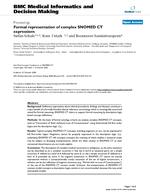Formal representation of complex SNOMED CT expressions
From International Center for Computational Logic
Formal representation of complex SNOMED CT expressions
Stefan SchulzStefan Schulz, Kornél MarkóKornél Markó, Boontawee SuntisrivarapornBoontawee Suntisrivaraporn
Stefan Schulz, Kornél Markó, Boontawee Suntisrivaraporn
Formal representation of complex SNOMED CT expressions
BMC Medical Informatics and Decision Making, 8(1):S9, 2008
Formal representation of complex SNOMED CT expressions
BMC Medical Informatics and Decision Making, 8(1):S9, 2008
- KurzfassungAbstract
Background: Definitory expressions about clinical procedures, findings and diseases constitute a major benefit of a formally founded clinical reference terminology which is ontologically sound and suited for formal reasoning. SNOMED CT claims to support formal reasoning by description-logic based concept definitions. Methods: On the basis of formal ontology criteria we analyze complex SNOMED CT concepts, such as "Concussion of Brain with(out) Loss of Consciousness", using alternatively full first order logics and the description logic EL. Results: Typical complex SNOMED CT concepts, including negations or not, can be expressed in full first-order logics. Negations cannot be properly expressed in the description logic EL underlying SNOMED CT. All concepts concepts the meaning of which implies a temporal scope may be subject to diverging interpretations, which are often unclear in SNOMED CT as their contextual determinants are not made explicit. Conclusion: The description of complex medical occurrents is ambiguous, as the same situations can be described as (i) a complex occurrent C that has A and B as temporal parts, (ii) a simple occurrent A' defined as a kind of A followed by some B, or (iii) a simple occurrent B' defined as a kind of B preceded by some A. As negative statements in SNOMED CT cannot be exactly represented without a (computationally costly) extension of the set of logical constructors, a solution can be the reification of negative statments (e.g., "Period with no Loss of Consciousness"), or the use of the SNOMED CT context model. However, the interpretation of SNOMED CT context model concepts as description logics axioms is not recommended, because this may entail unintended models. - Forschungsgruppe:Research Group: AutomatentheorieAutomata Theory
@article{ SchMarSun-BMC-08,
author = {Stefan {Schulz} and Korn{\'e}l {Mark{\'o}} and Boontawee {Suntisrivaraporn}},
journal = {BMC Medical Informatics and Decision Making},
number = {1},
pages = {S9},
title = {Formal representation of complex {SNOMED CT} expressions},
volume = {8},
year = {2008},
}
